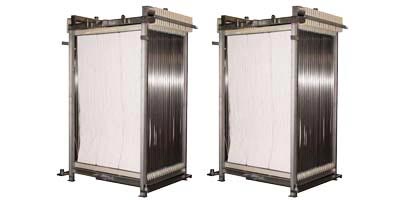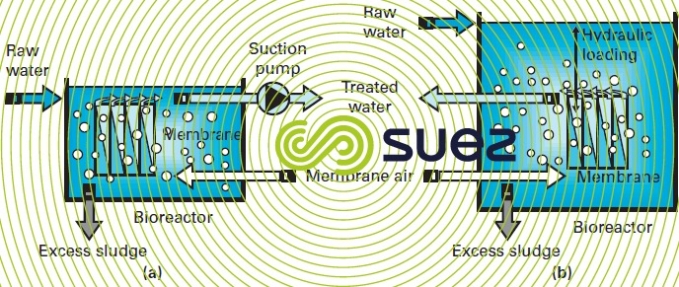Membrane Bioreactor as a Sustainable Solution for High-Volume Wastewater Treatment
Membrane Bioreactor as a Sustainable Solution for High-Volume Wastewater Treatment
Blog Article
Membrane Layer Bioreactors Discussed: Effective Solutions for Tidy Water
Membrane bioreactors (MBRs) have arised as a sophisticated option for dealing with the pushing challenges of wastewater treatment - Membrane Bioreactor. By incorporating biological processes with innovative membrane filtering, MBRs not just enhance the top quality of cured water but also lower the spatial requirements of treatment centers.

What Are Membrane Bioreactors?
Membrane layer bioreactors (MBRs) are innovative wastewater therapy systems that incorporate organic deterioration processes with membrane layer purification modern technology. This combination permits the effective elimination of impurities from water, making MBRs a favored choice in various applications, consisting of local wastewater treatment and commercial effluent administration.

One of the vital benefits of MBRs is their capacity to produce premium effluent, often suitable for reuse in watering or commercial procedures. In addition, MBRs require a smaller footprint compared to traditional therapy systems, making them excellent for urban settings where space may be limited.
Furthermore, MBRs can successfully manage differing influent lots and are much less susceptible to the effects of harmful shocks. These qualities add to their growing popularity as a lasting remedy for resolving the raising need for clean water while reducing environmental impacts.
How Membrane Layer Bioreactors Job
While the operation of membrane bioreactors (MBRs) might appear complicated, it essentially revolves around the harmony in between biological processes and membrane layer filtering. MBRs integrate a biological therapy procedure, usually activated sludge, with a membrane splitting up system to treat wastewater successfully.
In an MBR system, wastewater is very first presented right into a bioreactor where bacteria degrade raw material and other pollutants. The biological task decreases the concentration of toxins while promoting the development of biomass. Following this biological therapy, the blended alcohol goes through membrane purification, which can be microfiltration or ultrafiltration, depending on the wanted effluent high quality.
The membrane layers function as a physical barrier, permitting water and small solutes to pass while preserving suspended solids and bigger molecules. This allows the system to maintain a high concentration of biomass within the activator, improving the therapy effectiveness.
Moreover, the constant splitting up of treated water from the biomass facilitates a small design and lessens the impact of the treatment facility. On the whole, the combination of organic destruction and membrane filtering in MBRs causes reputable and reliable wastewater therapy, guaranteeing high-grade effluent suitable for different applications.
Benefits of MBR Modern Technology
Among the key advantages of membrane bioreactor (MBR) technology is its capacity to produce premium effluent with a significantly decreased footprint contrasted to conventional wastewater therapy approaches. MBR systems properly combine organic therapy and membrane layer purification, resulting in superior removal of contaminants, including suspended solids, pathogens, and organic issue. This capacity brings about effluent that frequently meets or exceeds stringent regulatory criteria for reuse and discharge.
In addition, MBR modern technology enables greater biomass concentrations, which enhances the therapy performance and minimizes the needed reactor quantity. This small style is particularly beneficial in urban locations where area is limited. discover this info here The functional versatility of MBR systems also means they can adapt to varying influent top qualities and circulation rates, making them ideal for a variety of applications.
Moreover, the decreased sludge manufacturing connected with MBR processes adds to lower functional and upkeep expenses. The membrane layers offer as a physical barrier, minimizing the threat of clogging and making it possible for longer operational durations between cleansing. In general, the benefits of MBR innovation make it an attractive option for sustainable wastewater therapy, addressing both ecological concerns and the requirement for reliable source administration.
Applications of Membrane Bioreactors
With their adaptability and efficiency, membrane bioreactors (MBRs) locate applications across different fields, including local wastewater therapy, industrial processes, and even water recovery. In municipal settings, MBRs give a compact service for dealing with wastewater, properly removing pollutants while all at once producing top notch effluent that meets strict regulative criteria. This makes them specifically suitable for areas with limited space.
In industrial applications, MBR modern technology is utilized for dealing with procedure water, especially in industries such as food and beverage, pharmaceuticals, and petrochemicals. These industries take advantage of MBRs' capability to manage high natural tons and their efficiency in recouping beneficial sources from wastewater, such as nutrients and water.
In addition, MBRs play an essential role in water reclamation initiatives, enabling the reuse of treated wastewater for watering, commercial procedures, and even as drinkable water after additional treatment (Membrane Bioreactor). straight from the source Their efficiency in removing contaminants and microorganisms makes them a reputable option for guaranteeing water quality in various reuse applications
Future of Water Therapy Solutions
The future of water treatment services is positioned for transformative innovations driven by technical development and increasing ecological understanding. As worldwide water scarcity comes to be a pressing issue, brand-new approaches, including membrane bioreactor (MBR) systems, are established to play a pivotal function in enhancing the performance and sustainability of water therapy procedures.
Arising innovations such as expert system and device understanding are anticipated to maximize treatment procedures, permitting real-time tracking and anticipating maintenance. This will enhance the general dependability and effectiveness of water therapy facilities. Improvements in membrane layer materials, such as graphene and nanofiltration, guarantee to raise permeation rates and decrease fouling, leading to reduced power intake and operational costs.
In addition, the assimilation of renewable resource sources into water treatment plants will certainly add to greener methods. The circular economic climate model will also obtain traction, encouraging the recuperation of valuable resources from wastewater, such as nutrients and energy.
Final Thought

Membrane bioreactors (MBRs) have emerged as an advanced option for attending to the pushing obstacles of wastewater therapy. By incorporating organic procedures with innovative membrane filtration, MBRs not just improve the top quality of cured water yet additionally lower the spatial needs of therapy centers.One of the crucial advantages of membrane layer bioreactor (MBR) modern technology is its capability to generate premium effluent with a significantly minimized footprint compared to conventional wastewater therapy methods.With their adaptability and efficiency, membrane bioreactors (MBRs) discover applications throughout various industries, consisting of click for more municipal wastewater treatment, industrial procedures, and also water reclamation.In final thought, membrane layer bioreactors stand for a significant development in wastewater treatment modern technology, incorporating organic processes with effective membrane filtering to generate high-quality effluent.
Report this page